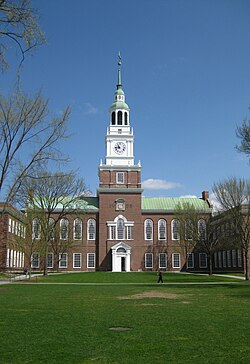 Shattuck Observatory in 2017 | |||
| Organization | Dartmouth College | ||
|---|---|---|---|
| Observatory code | 307 | ||
| Location | Hanover, New Hampshire | ||
| Coordinates | 43°42′18″N72°17′07″W / 43.70500°N 72.28528°W | ||
| Established | 1854 | ||
| Website | www | ||
| Telescopes | |||
| |||
 | |||
| | |||
Shattuck Observatory is an astronomical observatory owned and operated by Dartmouth College in Hanover, New Hampshire, United States.
Contents
The observatory's most notable director was Edwin Brant Frost, who went on to be the director of the Yerkes Observatory. Today, it is primarily used for instructional purposes, but is open for public observation of the stars on Friday evenings. For scientific work Dartmouth has shares in the MDM Observatory on Kitt Peak, Arizona, and the Southern African Large Telescope in South Africa. [1]


